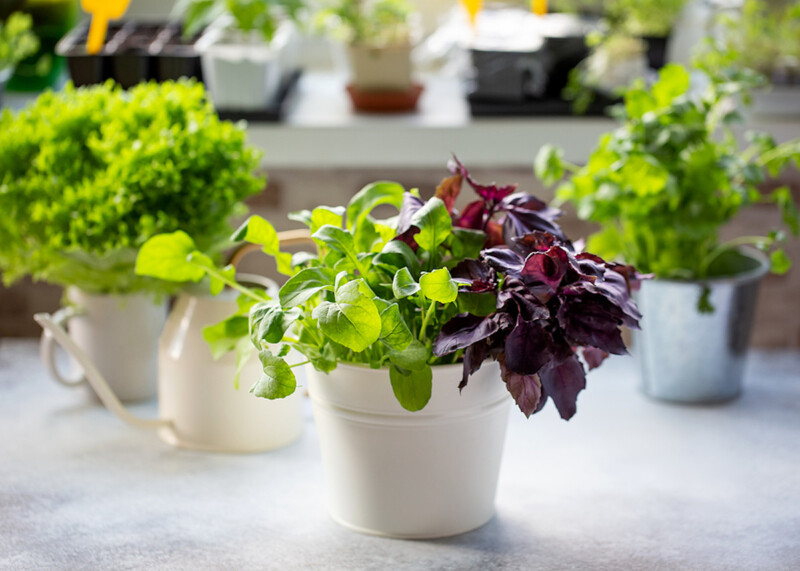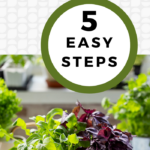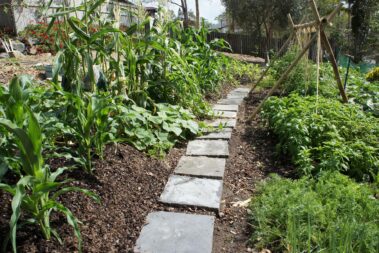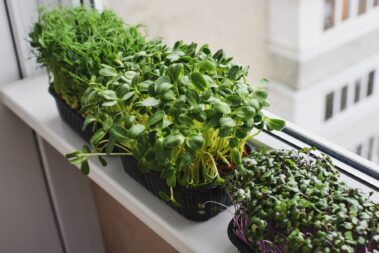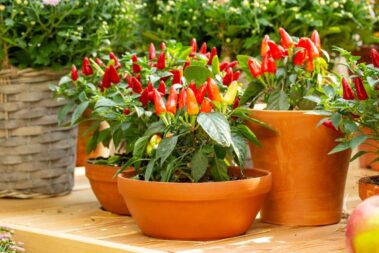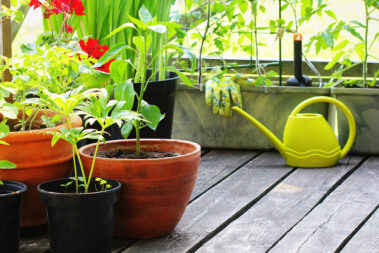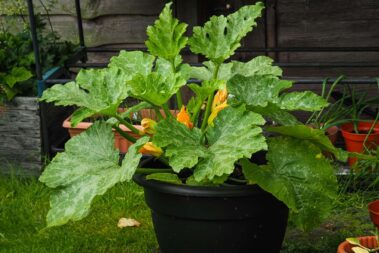Incorporating fresh herbs into your diet comes with a long list of benefits. Like ripe fruits and veggies, fresh herbs are packed full of nutrients and enzymes that dried herbs lack. Fresh herbs also bring more flavor to meals. Plus, when you grow your own herbs, you’ll save money on groceries.
One of the best ways to take advantage of all the benefits of fresh herbs is to create your own indoor herb garden. Not only will this put flavorful, aromatic herbs right at your fingertips, it will also allow you to enjoy a fresh harvest all year long.
Don’t worry if your gardening experience is limited. We’ll walk you through the process of setting up your indoor herb garden in five easy steps. Then we’ll look at some creative solutions to allow your herb garden to thrive even if your space is less than optimal.
Table of Contents
How to Grow Fresh Herbs Indoors
Ready to fill your kitchen or living space with beautiful, edible herbs? Let’s get started!
1. Choose the right plants
With enough light and attention, you can grow just about any herb inside. But there are certain species of herbs that fare better indoors than others. If you are new to indoor gardening, we recommend choosing your preferred variety of oregano, thyme, rosemary, basil, parsley, cilantro, or chives. Mint is also another good candidate, especially for novice gardeners, as it tends to grow rapidly and is difficult to kill.
You can start your indoor herb garden with seeds, seedlings from your local nursery, or with cuttings from your outdoor garden or produce drawer. If you go the cuttings route, just make sure you clip a branch with a node and allow roots to develop in water before transplanting into pots.
2. Choose the right pots
Finding adorable pots and containers to match the aesthetic of your kitchen is one of the most enjoyable parts about creating your indoor herb garden. Any color, material, and shape will do so long as it has good drainage and is big enough to support a mature plant. We recommend pots with a minimum diameter of four inches to start. You’ll also want to make sure the pots come with a tray or dish to protect your counter or window sill from water damage.
Once you have your pots, fill them with organic potting soil. Regular garden soil or dirt from outside will dry out too fast and doesn’t contain enough nutrients for potted plants.
3. Find the best spot
The trick to growing thick, beautiful herbs indoors is to find a bright, sunny location. A south-facing window is the best option, but large, bright west or east windows will work as well. Make sure to rotate your plants frequently as they mature to assure thick growth on all sides.
If you don’t have a sunny window available, you aren’t out of luck. We’ll look at some creative solutions to overcoming a lack of light in the next section.
4. Water, feed, repeat
Herbs enjoy moist soil, but won’t fare well if they get too soggy. Good drainage will help avoid that problem while consistent watering will keep your pots from drying out. Check your soil daily by pressing on the dirt near the base of the plant. As soon as it feels dry to the touch, place your herbs in the sink and give them a good soaking. Allow them to drain thoroughly before placing them back on their tray.
Herbs tend to be easy keepers and don’t rip through nutrients as fast as vegetables do. But any plant grown in a container long enough will eventually need to be fertilized. An all-purpose liquid organic fertilizer added about once a month should suffice.
5. Harvest and enjoy
Once your plant has numerous leaves and more than a few branches, begin harvesting by pinching off sprigs just above a mature leaf pair. Harvesting frequently from all sides of the plant will encourage bushy, symmetrical growth. This is true of most thicker-branched herbs like basil, oregano, and rosemary.
For thin-branched herbs like cilantro, harvest sprigs by taking the top third of the branch. This will allow plenty of regrowth in the lower portion of the plant. For chives, cut individual leaves about an inch above the soil.
Creative Ways to Grow Herbs Indoors (Sunny Window Optional)
Have a north-facing kitchen window? Or lack the space on your windowsill to keep pots? You can still grow a productive herb garden, so long as you’re willing to get a little creative. Here are some of our favorite solutions to a less-than-ideal indoor garden space.
[hfcm id=”19″]
Grow Lamps and Mini Lights
The number one issue most people will run into when growing herbs indoors is a lack of light. Even some south-facing windows fail to allow enough light in the winter months or get blocked by foliage in the summer. Mini grow lights that attach to the window sill or to the pots themselves, like these from Vogek, are perfect for supplementing light in these situations.
If you don’t have space to spare next to a window, a floor or desk grow lamp might be a better solution. These lights are larger and brighter to supply all the light your herbs will need. These types of lights are self-supporting and much more aesthetically pleasing than your typical grow light.
No products found.
Vertical Planters
If your problem is more one of space than light, a vertical planter may be a good solution. These types of containers have a small footprint and multiple openings up the sides to allow plants to grow one on top of the other. They have a similar structure and look as a vertical wall planter but without the need to sacrifice wall space or break out the drill.
Like your typical potted herb, these planters do need to be rotated frequently to make sure the plants on all sides get enough light. Many options, like this vertical planter from Mr. Stacky, allow you to change the height and number of cells depending on how many herbs you are growing.
Wall Mounted Vertical Gardens
If you do have the wall space, a mounted vertical garden is an effective solution and a beautiful addition to any space. These systems use low-profile angled pockets that allow the plants plenty of room to grow without taking up a lot of space.
Best of all, there is an endless number of designs available from this simple waterproof cloth hanger from Angtuo, to this smart self-watering hanger from Generic.
Hanging Pots
Another great way to create an indoor herb garden when you are short on space is to use a hanging pot system. Not only will these free up space on your counter and windowsill, but many of them look gorgeous and add a lot of character to the room.
Some hanging pot systems work with an overhead bar while others are attached to the window with suction cups or to the wall with individual hooks. Whichever one you choose, drainage is likely to be an issue. Instead of planting your herbs directly in the pots provided, we recommend finding a plastic insert with drainage holes that will fit nicely into the containers. This way you can remove the herbs to water them and avoid the soil becoming too waterlogged.
No products found.
Light and Shelf Systems
If you’re serious about growing prolific herbs all year long, a sophisticated shelf and grow light system might be the best option for you. These systems tend to be highly customizable and come in a variety of sizes, colors, and designs.
You can even build your own shelf system using thin strip grow lights like these from Mosthink. Simply attach the lights to the underside of an old set of shelves or custom unit and run the chords out the back. Your plants will get all the light they need and you’ll be able to put them anywhere you have space. You can even utilize the extra space on the shelves for cookbooks and other kitchen essentials.
No products found.
However you end up designing your indoor fresh herb garden, we’re pretty sure the only thing you’ll regret is not doing it sooner!
- How to Pick the Perfect Watermelon For a Sweet Summer Treat - April 10, 2024
- Future Kind’s Foundations: A Multivitamin Made for Vegans - December 5, 2023
- Does Nutritional Yeast Go Bad? - November 28, 2023

